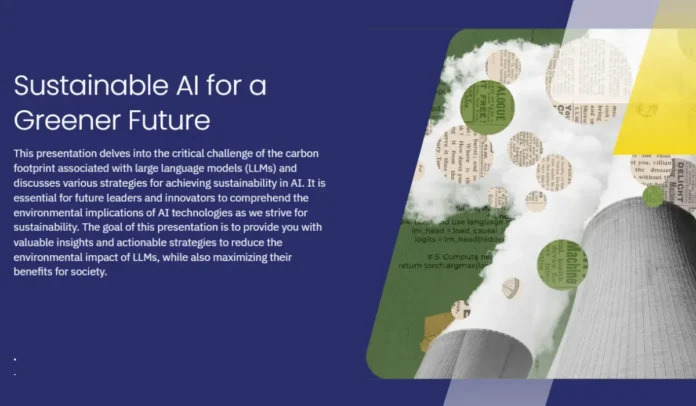Artificial Intelligence is powering a new era of innovation from automated customer service to predictive healthcare and intelligent content creation. However, beneath this technological boom lies a pressing concern: its environmental footprint. Large Language Models (LLMs) like GPT-4, LLaMA, and PaLM require enormous computational resources to train and run, which translates into high carbon emissions. For example, training a single AI model can emit as much CO₂ as five cars in their lifetime. As AI becomes central to business and society, addressing its sustainability is no longer optional, it’s a necessity.
This article explores how the tech industry can mitigate the environmental impact of LLMs by adopting sustainable AI strategies, including model optimization, greener hardware, and carbon-aware practices.
Why LLMs Consume So Much Power
Training a Large Language Model involves massive datasets often comprising hundreds of billions of tokens and runs across thousands of GPUs for days or even weeks. Each training run consumes megawatts of electricity. The main reasons behind this energy intensity include:
Model Complexity and Size
Modern LLMs have billions to trillions of parameters. More parameters mean better performance, but also higher computational requirements.
Volume of Training Data
Training involves parsing and learning from a vast corpora of internet data, demanding significant memory and disk throughput.
Infrastructure & Hardware
Most AI training is conducted in hyperscale data centers packed with power-hungry GPUs. These centers often run on non-renewable energy unless specifically designed to be green.
Model Retraining and Fine-tuning
Beyond initial training, fine-tuning, updates, and deployment across devices consume additional resources, contributing to the ongoing energy cost.
Energy-Efficient AI Techniques
In response to the carbon challenge, researchers and engineers have started employing various model optimization strategies. These innovations help reduce energy demands without compromising performance:
1. Model Pruning
By removing unnecessary weights and neurons from a neural network, pruning reduces the size and complexity of models. This translates into faster inference and lower power consumption ideal for on-device applications.
2. Quantization
Quantization reduces the precision of weights and computations (e.g., from 32-bit floats to 8-bit integers). This drastically lowers memory use and energy cost while maintaining model accuracy within acceptable margins.
3. Knowledge Distillation
This technique involves training a smaller, efficient “student” model to replicate the performance of a larger “teacher” model. The result is a lighter model that delivers similar results using less compute power.
4. Low-Rank Factorization
Low-rank approximation methods break down large weight matrices into more manageable chunks, allowing faster and more efficient computation with fewer multiplications.
5. Sparse Models
Unlike dense models that activate all neurons at once, sparse models selectively activate parts of the network. Google’s Switch Transformer is a prime example, achieving superior performance with fewer active parameters.
These techniques form the backbone of energy-conscious AI development and are rapidly becoming industry standards for enterprises wanting to scale responsibly.
Green Hardware & Sustainable Data Centers
Even the most optimized models require infrastructure to run. That’s where green hardware and sustainable data centers come into play.
The Tech Leaders continue to explore the environmental implications of artificial intelligence. In Part 1, we examined the energy demands of Large Language Models (LLMs) and techniques like pruning and quantization that help optimize performance while minimizing carbon output. In this part, we’ll explore the broader ecosystem of sustainable AI—from green infrastructure to carbon-aware strategies plus practical advice for developers and an outlook on the future of eco-conscious AI.
Renewable Energy Adoption
Top AI providers like Google, Microsoft, and Amazon are investing in data centers powered by solar, wind, and hydroelectric energy. Google Cloud, for instance, aims to operate entirely on carbon-free energy by 2030.
Advanced Cooling Systems
Traditional data centers rely on air conditioning, which increases electricity usage. In contrast, liquid cooling and AI-optimized airflow systems help manage temperatures more efficiently and cut down overall power consumption.
PUE Optimization
Power Usage Effectiveness (PUE) measures the efficiency of a data center. The closer it is to 1.0, the better. Tech leaders strive for PUEs below 1.2, integrating AI systems to dynamically adjust power and cooling requirements.
Sustainable AI at Scale: Case Studies
OpenAI
While not carbon-neutral yet, OpenAI collaborates with Microsoft Azure’s carbon-conscious data centers to train its models. They’re also researching more efficient LLM architectures.
Hugging Face
This open-source leader encourages using smaller models and community-shared checkpoints to reduce the need for repeated training. Their “Carbon Emissions” tab on model pages promotes transparency.
DeepMind
DeepMind has experimented with model compression and has shared benchmarks showing significant energy savings through smarter architectures like GShard and AlphaFold.
Carbon-Aware Training & Offset Strategies
Sustainable AI goes beyond architecture and infrastructure. It involves when, where, and how models are trained.
Time-Based Training
Companies can schedule training jobs during periods when renewable energy is abundant (e.g., sunny or windy hours), reducing reliance on fossil fuels.
Location-Based Training
Running training jobs in regions powered by clean grids (like parts of Scandinavia or Canada) can significantly cut carbon emissions.
Carbon Offsetting
Some companies fund reforestation or renewable energy projects to offset their emissions. While this isn’t a perfect solution, it’s a step toward responsibility.
Best Practices for Developers and Enterprises
If you’re building or deploying AI systems, here’s how you can reduce your carbon footprint:
- Choose pre-trained models instead of training from scratch
- Use model compression techniques (pruning, quantization, distillation)
- Host on green cloud platforms with certified energy practices
- Share models and checkpoints to reduce redundant computation
- Evaluate necessity, don’t deploy massive models for trivial tasks
By adopting these practices, developers can help build an ecosystem of responsible innovation.
Future Outlook: Where Is Green AI Headed?
The next frontier in sustainable AI involves neuromorphic computing, optical chips, and biologically inspired architectures that mimic the energy efficiency of the human brain.
Meanwhile, regulatory pressure may soon require carbon reporting for AI deployments, pushing transparency in AI development.
There’s also increasing interest in federated learning and on-device AI, reducing the need to send data to central, energy-intensive servers.
Conclusion
Sustainable AI isn’t a niche, it’s a movement. As large language models become part of everyday tech, their energy consumption and environmental impact must be part of the conversation. Through smarter architectures, cleaner infrastructure, and mindful development, we can strike a balance between innovation and ecological responsibility.
FAQs
Can reducing model size affect performance?
Yes, but with advanced techniques like knowledge distillation, performance drops can be minimal while drastically improving efficiency.
Is sustainable AI more expensive?
Not necessarily. Efficient models often reduce cloud costs and hardware strain, saving money in the long term.
Which platforms support green AI?
Google Cloud, Microsoft Azure, and AWS all offer sustainability-focused options for developers and businesses.
Can individuals contribute to AI sustainability?
Absolutely. Choosing efficient models, using pre-trained models, and supporting open-source initiatives all make a difference.
Will governments regulate AI carbon emissions?
It’s likely. As AI grows in usage, regulatory frameworks will likely evolve to address its environmental footprint.



































